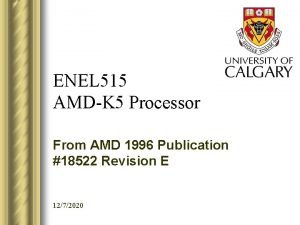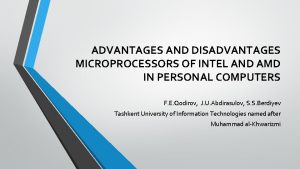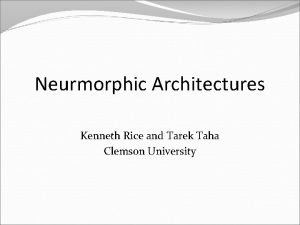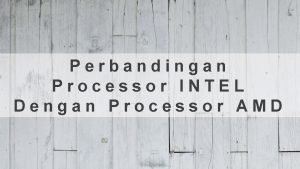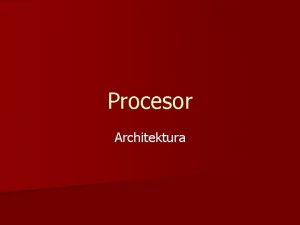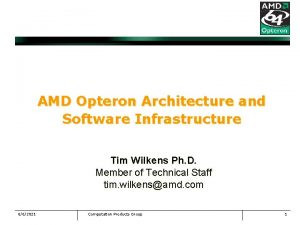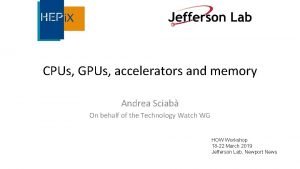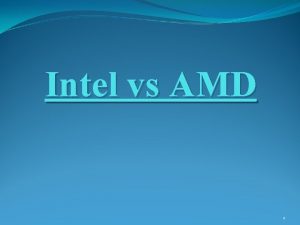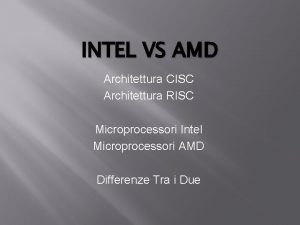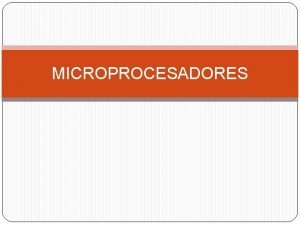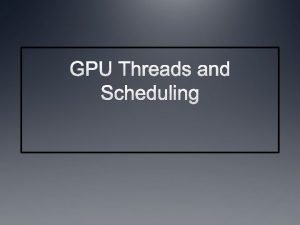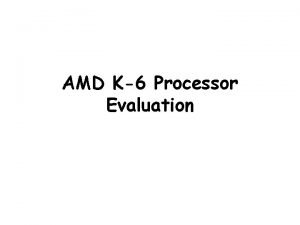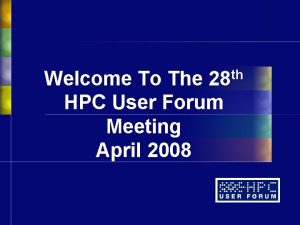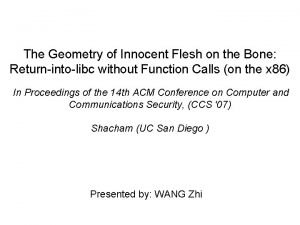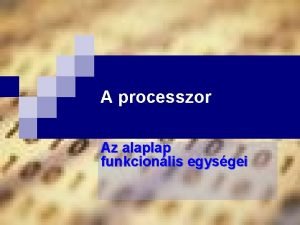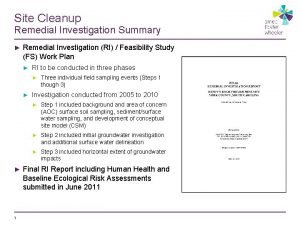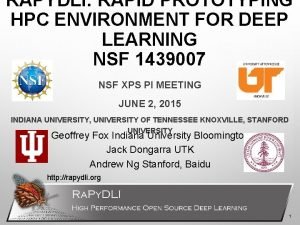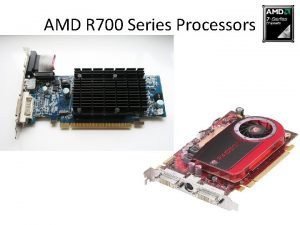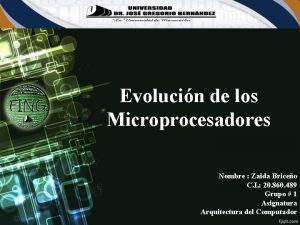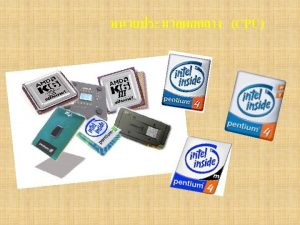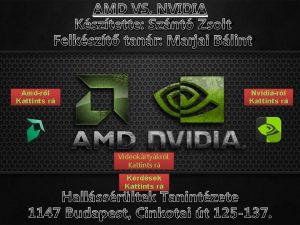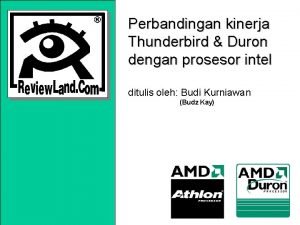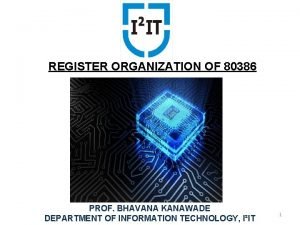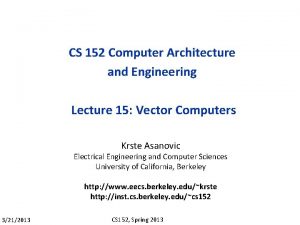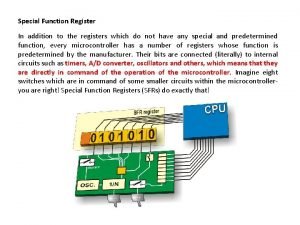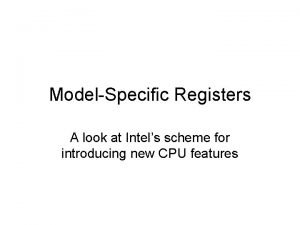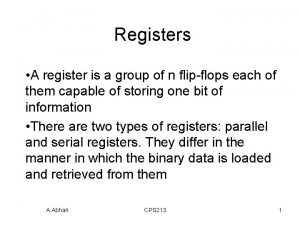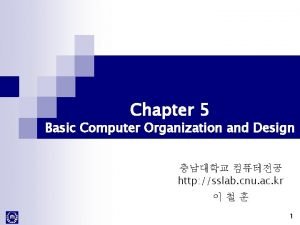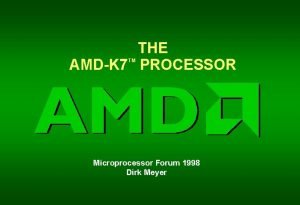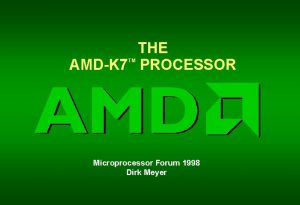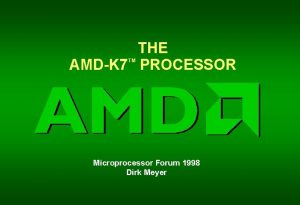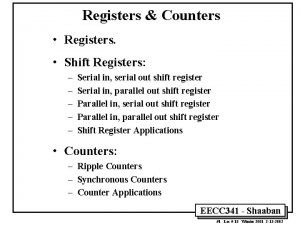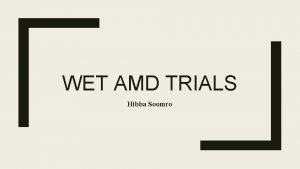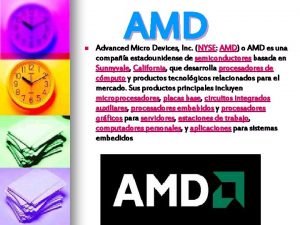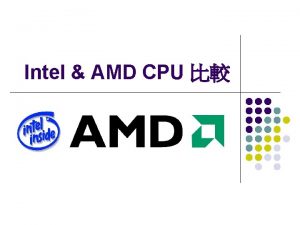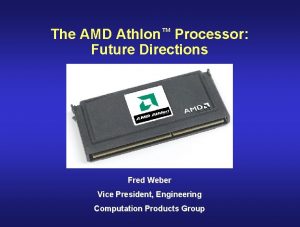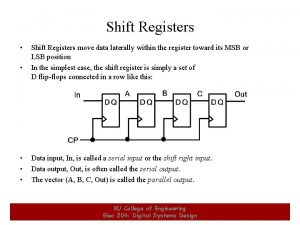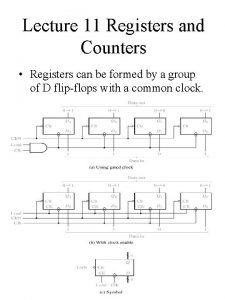AMD K6 Processor Evaluation Registers AMDK 6 Registers















































- Slides: 47

AMD K-6 Processor Evaluation

Registers

AMD-K 6 Registers • General purpose registers • Segment registers • Floating point registers • MMX registers • EFLAGS register

Continue. . . • Control registers • Task register • Debug registers • Test registers • Descriptor/memory registers • Model-specific registers (MSRs)-Model 6

General-Purpose Registers • 8 32 -bit general-purpose registers • EAX • EBX • ECX

Continue • EDX • EDI • ESP • EBP

Segment registers • 6 16 -bit segment registers • Used as pointers to areas (segments) of memory • CS • DS • ES

Continue • FS • GS • SS

Floating-Point Registers • 8 80 -bit numeric floating point registers • Help the floating-point execution unit • Labeled FPR 0–FPR 7

MMX Registers • 8 64 -bit MMX registers • Used by multimedia software

EFLAGS Register • Provides for three different types of flags – System flags – Control flag – Status flags

Control Registers • 5 control registers • Contain system control bits and pointers

Task Register • Contains a pointer to the Task State Segment of the current task

Debug Registers • 8 Debug registers • Labled DR 0 -DR 7

Descriptors • Define, protect, and isolate code segments, data segments, task state segments, and gates

Memory Management Registers • The AMD-K 6 processor controls segmented memory management with 4 registers: – Global Descriptor Table Register – Interrupt Descriptor Table Register – Local Descriptor Table Register – Task Register

Model-Specific Registers (MSR) • 5 MSRs – – – Machine Check Address Register (MCAR) Machine Check Type Register (MCTR) Test Register 12 (TR 12) Time Stamp Counter (TSC) Write Handling Control Register (WHCR)

MCAR and MCTR • Both are 64 -bit • The AMD-K 6 processor does not support the generation of a machine check exception, so these are used MCAR and MCTR are used instead

Test Register 12 • Disable the L 1 caches

Time Stamp Counter (TSC) • 16 -bit • The time stamp counter (TSC) MSR is incremented by the processor with each process or clock cycle

Write Handling Control Register (WHCR) • Contains three fields: WCDE bit, Write Allocate Enable Limit (WAELIM) field, and the Write Allocate Enable 15 -to-16 Mbyte (WAE 15 M) bit

CPU SPEED

CPU SPEED • Very fast under Windows NT 4. 0 • The 32 -bit performance is excellent • Runs Windows 95 faster than the Intel Pentium MMX

Continue • Good choice for a great gaming machine • Good engine for running Microsoft Office, surfing the net, and checking email

Continue • If Windows NT is the primary operating system, the AMD K 6 should be considered as a low cost but good performing alternative to a Pentium Pro or Pentium II

CPU Type: RISC 86

RISC 86 Superscalar Microarchitecture • RISC 86 microarchitecture - Internally translates x 86 instructions into RISC 86 operations – x 86 Instructions - 1 to 15 bytes – RISC 86 opcodes - simpler fixed-length • Superscalar operation - multiple decode, execution, and retirement – Centralized Schedule Buffer/ Instruction Control Unit • Buffers and manages up to 24 RISC 86 operations at one time – Equates to 12 x 86 instructions – Multiple Decoders • Buffer can receive up to 4 RISC 86 operations from decoders in 1 clock – 7 Parallel Execution Units • Buffer can issue up to 6 RISC 86 operations to execution units in 1 clock

x 86 Instruction Categories (Short and Long Decodes) • Short Decode – Common x 86 instructions 7 bytes in length – Produce 1 RISC 86 operations – 2 processed per clock – Processed completely within the decoders • Long Decode – More complex and somewhat common x 86 instructions 11 bytes in length – Produce up to 4 RISC 86 operations – 1 processed per clock – Processed completely within the decoders

x 86 Instruction Categories (Vector Decode) • Vector Decode – Complex x 86 instructions requiring long sequences or RISC 86 instructions – 1 processed per clock – Decoders generate an initial set of 4 RISC 86 operations • Decode is completed by fetching a sequence of additional operations from an on-chip ROM at a rate of 4 operations per clock

RISC 86 Operations Categories • • • Memory load operations (load) Memory store operations (store) Integer register operations (alu/alux) MMX register operations (meu) Floating-point register operations (float) Branch condition evaluations (branch)

x 86 to RISC 86 Translation Example

Instruction Set

Instruction Set • Categories – Arithmetic – Conversions – Logical Operations – Transfers and Memory Operations • Compatibility – Uses full Intel Instruction Set • Features – Three Separate Instruction Sets • Integer Instruction Set • Floating-Point Instruction Set • MMX Instruction Set

Technologies Used

Technologies Used • • RISC 86 Superscalar microarchitecture – This enables leading-edge performance on both Microsoft Windows 95 and Windows NT operating systems, and the installed base of x 86 software Socket 7 -compatible Bus Interface – This allows PC manufacturers and resellers to leverage today’s infrastructure to quickly bring superior price/performance PC systems to market

Detailed Comparison of the K-6 to the Intel Pentium

Continued

Continued

Factors Affecting Performance

Factors Affecting Performance • • • Pipelining, prefetching, and predecoding – Using a 32 byte instruction cache line, lines are prefetched and predecoded. This enables the decoders to efficiently decode multiple instruction simultaneously Multiple Decoders – The decoders issue up to four opertions at a time to the centralized schedule buffer which buffers and manages up to 24 operations at a time. Parallel Execution Units – The Instruction Control Unit issues up to six instruction to the execution units and they are executed in parallel

Addressing Modes

Memory Map

Addressing Modes • Direct Addressing: - address operand byte points directly to the target data - only for internal RAM • Indirect Addressing: - two address operand bytes pointing to another pair of address bytes, containing the address of the operand - for internal and external RAM • Immediate Constants: - value of a constant can follow the operation code in the program memory • Indexed Addressing: - only program memory can be accessed - only read operations are possible - addressing mode reads lookup tables in the program memory - base register points to the base of the table entry and the accumulator is set up with the table entry number

Addressing Modes • Register Instructions: - for register banks containing registers from R 0 to R 7 - 3 -bit register specification in the operation code of the instruction - no address byte • Register-Specific Instructions: - some instructions are specific to certain registers - no address byte necessary - operation code does the pointing itself

Perspective On Role In The Market Place • Microprocessor Market: - short product life cycles - migration to higher performance microprocessors - dominant position of Intel Corporation ¨ setting standards ¨ affecting margins and profitability of competitors ¨ restricting innovation and differentiation of product offerings - successful competition possible if: ¨ new process technologies ¨ higher performance microprocessors ¨ greater volumes ¨ significant capital expenditures

AMD-K 6 Processor Family Roadmap

Perspective On Role In The Market Place - K 6 - key element of further developments - aggressive technology transition schedule - possible risks and uncertainties: ¨ successful fabrication of higher performance AMD-K 6 ? ¨ Intel’s new product introduction, marketing strategies and pricing ? ¨ continued development of worldwide market acceptance ? ¨ availability of financial and other resources ? ¨ possible adverse market conditions in the PS market ? ¨ unexpected interruptions of production ?
 Amdk meaning
Amdk meaning Sni 3554 2015
Sni 3554 2015 Disadvantages of amd processor
Disadvantages of amd processor Amd rome processor
Amd rome processor Tulisan amd
Tulisan amd Amd opteron
Amd opteron Tim wilkens
Tim wilkens Amd server market share
Amd server market share Yours mine amd ours
Yours mine amd ours Amd vs intel history
Amd vs intel history Differenza tra intel e amd
Differenza tra intel e amd Amd bc-250
Amd bc-250 Evolución de los microprocesadores
Evolución de los microprocesadores Amd gpu scheduling
Amd gpu scheduling Ben sander amd
Ben sander amd Amd k 6
Amd k 6 Amd hpc user forum
Amd hpc user forum Amd razeon
Amd razeon Amd v technology
Amd v technology Amd farm
Amd farm The geometry of innocent flesh on the bone
The geometry of innocent flesh on the bone Wet amd
Wet amd Processzor fogalma
Processzor fogalma For amd
For amd Proses penggosokan lensa
Proses penggosokan lensa Nervana11
Nervana11 Irt to amd
Irt to amd Nombre
Nombre Socket pga
Socket pga Nvidia leányvállalatok
Nvidia leányvállalatok Amd duron 600
Amd duron 600 Tulisan amd rmik
Tulisan amd rmik Amd akupunktur
Amd akupunktur Dma controller 8237
Dma controller 8237 Vga registers
Vga registers What is the use of test registers in 80386?
What is the use of test registers in 80386? Vector registers
Vector registers Registers
Registers Register storage
Register storage Fabavb
Fabavb Registers in computer
Registers in computer Vocal registers
Vocal registers Counters shift registers
Counters shift registers What are special function registers
What are special function registers Intel msr list
Intel msr list General purpose registers in assembly language
General purpose registers in assembly language Register is a group of
Register is a group of Design of accumulator logic in computer architecture
Design of accumulator logic in computer architecture
